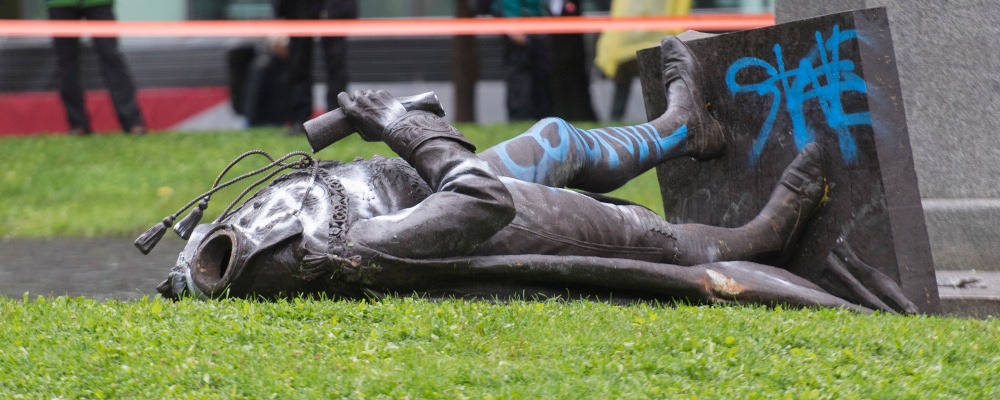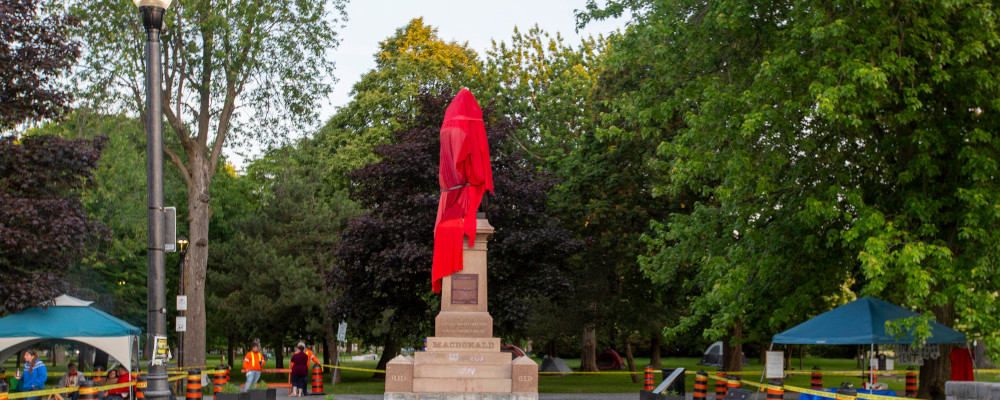Parks Canada launched its new characterization of Sir John A. Macdonald over the Victoria Day long weekend when it reopened Bellevue House in Kingston, Ontario after six long years of restoration. The spectacle, steeped in identity politics, has rightly been criticized for portraying our founding prime minister as among Canada’s worst-ever villains.
For fans of Canadian architecture and home design and for friends of history, this was an important event. Bellevue House is a gem in the Canadian urban landscape. It was built in 1840 for a prosperous Kingston merchant in an improbable Italian Villa style that features a square central tower and two wings deployed on either side. Think of it as a proud Canada goose standing and opening its wings, inviting visitors inside. It is as welcoming today as it was when I first visited it as part of a school field trip in grade 7, well over 50 years ago.
Macdonald rented the place for about a year in 1848-1849. Back in those days, it was located in the suburbs of Kingston and he had picked it as a place of rest for his wife Isabella who had given birth to their first child John Jr. It was a big house—far too big for a small family—and it was expensive. Sadly, it turned out to be the place of terrible tragedy for the young couple, as their son died there before he was barely a year old.

In Macdonald’s long and impressive life, Bellevue House is nothing but an asterisk. His stay was short, no big decisions were hatched there, he never owned it, and he did not even write about it. Two other places in Canada are far more important: the Macdonald-Mowat House on St. George Street in Toronto, which has been beautifully restored by the University of Toronto, and Earnscliffe, Macdonald’s grand home overlooking the Ottawa River in Ottawa, which has long been owned by the British government (it serves as the private residence of the British High Commissioner).
Ottawa bought Bellevue House in 1964 in preparation for Canada’s Centennial. It was opened as a historic park three years later. Because of its association with Canada’s first prime minister, a connection between exquisite architecture and politics was cemented.
The Trudeau government had choices to make when it closed the house for long-overdue repairs in 2017 (it had suffered neglect and its visiting hours had been reduced by the Harper government). It could have sold it for redevelopment. It could have negotiated an arrangement with Kingston so as to offer much-needed museum space to a beautiful city that has done everything to show it no longer wants any association with its most famous resident.
It could have approached nearby Queen’s University to make the place useful all year round to students (instead it will be mothballed for eight months each year). It could have made it a museum dedicated to Indigenous Peoples or to Canada’s multiculturalism. Why not a museum dedicated to Canada’s workers? Instead, it decided to keep Bellevue House fixated on Macdonald. The website for the national historical site now opens with telling lines. From the second word, the link is made between Macdonald and the First Nations:
Hello, Shé:kon, Aaniin. At Bellevue House National Historic Site, many voices present the complex legacy of Canada’s first prime minister, Sir John A. Macdonald. Come for the experience, engage with the stories, and join the conversation about Canadian history.
It continues:
Don’t miss this opportunity to experience the history of Sir John A. Macdonald in the 1840’s setting, while engaging in conversations about the complex and lasting legacies of Canada’s first prime minister.
There is no hint of official bilingualism. Nothing about nation-building, about the achievement of institutionalizing Confederation, or about the hardships of politically uniting a difficult country. Not a word about the economic difficulties that marked Macdonald’s time, or about the massive emigration from Canada in those years. Nothing about the hardships of women in the 19th century, or about the children who were lucky to survive past age 10 and who were typically sent to work from that point onwards.
Instead, the re-opening of the historic Bellevue House provides yet another embarrassing display of national flagellation, triggered by the adoption of the Trudeau government’s Framework for History and Commemoration (2019), a short-sighted guideline not designed to enlighten but instead to demonize Canada’s past and those who (mostly volunteered) to preserve it.

The opening ceremonies were clear: the mission of the reborn national site is not to celebrate Kingston’s most important (by far) citizen, a man who led a national party to six electoral majorities and who was joyously celebrated in his own lifetime even by his adversaries, but to trot out the usual tropes: he was a racist, a drunk, a man who hated Indigenous peoples to the point of starving them or forcing them to go to school. A man who probably did not like women or immigrants either. Couched in terms of a “timely conversation” the Parks Canada staff’s apparently closed-door consultations with local Indigenous groups recrafted the focus to be Macdonald-Bellevue.
Not surprisingly, there is a display about residential schools. Academic Channon Oyeniran gave introductory remarks at the reopening ceremony and talked about how the event was a “testament” to the “rewriting of this history.” She was being honest. No known historian of Macdonald, Kingston, or Victorian Upper Canada was even invited.
Dan Maracle, the chief of the Mohawks of the Bay of Quinte, was quoted as saying that Bellevue “Now does a better job of encompassing all of Macdonald’s legacy,” urging Canadians “to learn more about the country’s Indigenous Peoples and their culture.” He continued: “If you learn about the history of the country, then that might actually create a desire to do better in the future.” One has to ask: what would Chief Maracle do without Macdonald the villain?
The reality is that Bellevue House is a fake, as it has always been. Its architecture was borrowed from a place far away and its association with John and Isabella Macdonald was tenuous at best. There are no Macdonald artifacts on display (except, maybe, a crib) because the family was house-poor and had little in the way of furniture—Macdonald was 34 years old, barely earning a living as a lawyer, with no money to buy the expensive items that are now on display and presented as totems of privilege.
To add insult to injury, Bellevue House will now be used to heave all the ills of the Victorian era on Macdonald’s shoulders. Ignoring the fact that he was the product of democracy, today the government of Canada, which he helped create, continues to ransack the history of the country and goes out of its way to ensure Macdonald gets a kicking.
The debacle at Bellevue House shows just how Prime Minister Trudeau continues to lead the march of the historical boodle brigade. His first step was to jettison Sir Hector Langevin, Macdonald’s favourite minister (a stalwart Quebec federalist who was as loyal and he was hard-working as minister of public works). The prime minister then did nothing to denounce the vandalism of Macdonald statues on his watch. Instead, he continuously disparages the politics and policies of his predecessors (Liberals included).
Among his final gestures will be this fiasco at Bellevue House. For this government cannot miss an opportunity, however small, to kneecap its first prime minister’s reputation. On the other hand, there will be plenty of opportunities to boycott Bellevue House.
Recommended for You

‘A bending of the knee’: Breaking down Mark Carney’s chummy chat with President Trump

David Polansky: Canada’s faux foreign policy leadership

‘There’s a reason why Americans want Canadian wood’: Derek Nighbor on the forestry sector’s comeback

Trump’s Middle East negotiations risk unsustainable Gaza deal, warns David Frum



